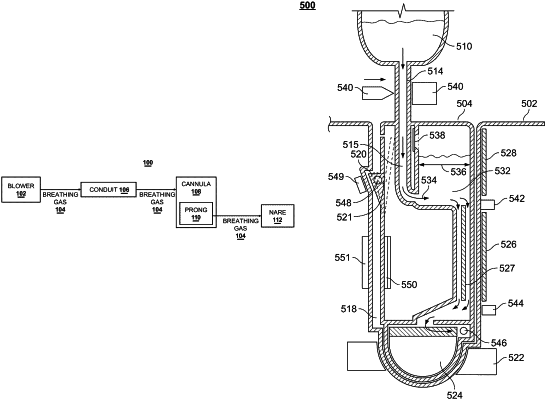| CPC A61M 16/0672 (2014.02) [A61M 16/0066 (2013.01); A61M 16/1045 (2013.01); A61M 16/20 (2013.01); A61M 2205/3334 (2013.01); A61M 2205/583 (2013.01)] | 33 Claims |

|
1. A system for providing respiratory therapy to a patient, the system comprising:
an attachable auxiliary unit;
a base unit comprising a recess sized and shaped to receive the attachable auxiliary unit, the base unit comprising an inner wall, the inner wall comprising a first surface that partly defines the recess and a second surface that is opposite from the first surface, the second surface partly defining an interior space of the base unit;
a low-pressure blower having an operational gauge pressure limit of less than 270 hPa, the blower configured to:
receive breathing gas from ambient air, a tank, or a wall outlet; and
output pressurized breathing gas at a pressure up to the operational gauge pressure limit;
a humidifier in fluid communication with the low-pressure blower, wherein the humidifier receives the pressurized breathing gas from the low-pressure blower and humidifies the breathing gas, wherein the humidifier further comprises:
an internal reservoir in the attachable auxiliary unit configured to contain a volume of a liquid;
a non-contact heat actuator of the base unit configured to heat the liquid in the internal reservoir when the attachable auxiliary unit is seated within the recess of the base unit, the heat actuator comprising a magnetic coil configured to heat, via induction, a plate disposed in the internal reservoir, wherein the heat is generated in the plate by the non-contact heat actuator by inducing eddy currents in the plate, the non-contact heat actuator positioned in the interior space and adjacent to the second surface; and
a level sensor of the base unit configured to measure a level of the liquid in the internal reservoir, the level sensor disposed in the interior space of the base unit alongside the internal reservoir and comprising a capacitive sensing circuit configured to measure change in capacitance of the liquid as the level of liquid changes when the attachable auxiliary unit is seated within the recess of the base unit;
a conduit in fluid communication with the humidifier and configured to receive heated and humidified breathing gas from the humidifier;
a non-sealing nasal cannula having at least one nasal prong, the nasal cannula being in fluid communication with the conduit and configured to receive the heated and humidified breathing gas from the conduit, the at least one nasal prong having a distal opening and being configured to provide the heated and humidified breathing gas through the distal opening to a nare of the patient;
wherein the at least one nasal prong is configured such that heated and humidified breathing gas exits the distal opening at an exit velocity of at least 40 m/s and less than 75 m/s and at a flowrate of at least 8 L/min and less than 80 L/min; and
a controller and a processor configured to:
receive first data indicative of one or more dimensions of the nasal cannula;
receive second data indicative of a flowrate of breathing gas; and
calculate the exit velocity based on the first data and the second data.
|